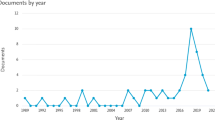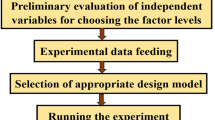Abstract
In many practical situations, it is important to evaluate the relationships between the factors that compose an industrial process and their effects on one or more response variables that are of interest to an enterprise. The main contribution of this present study is to propose a new conceptual hybrid framework based on the DMAIC (Define, Measure, Analyze, Improve, and Control) methodological structure, to optimize complex experimental problems with multiple responses. This procedure combines Response Surface Methodology, with the Desirability (D), Modified Desirability (MD), Compromise Programming (CP) functions, with Generalized Reduced Gradient (GRG) and Evolutionary Algorithms (EA). We made real application to a glass lamination process case study to describe how to use the proposed framework. The procedure allowed several configurations to be tested involving the D, MD and CP functions, adopting the GRD and EV, to optimize the studied industrial process. The best configuration was defined by a practical confirmation experiment and validated by company engineers and experts. As examples of the advantages of adopting the proposed framework in the glass lamination problems, the best solutions resulted in a 49.86% increase in grinding wheel shelf life, corresponding to a 927kg reduction of steel-use per year, and a 41.7% reduction in dressing stone consumption, saving 17,200 stones per year.
























Similar content being viewed by others
Data availability
We attach the VBA-Excel programming used in the modeling and optimization.
References
Prashar A (2016) A conceptual hybrid framework for industrial process improvement: integrating taguchi methods, shainin system and six sigma. Prod Plan Control 27(16):1389–1404
Montgomery DC, Runger GC (2020) Applied Statistics and Probability for Engineers. Wiley; 7th edition
Silva A, Marins FAS, Dias EX, Oliveira JBS (2019) Modeling the uncertainty in response surface methodology through optimization and monte carlo simulation: An application in stamping process. Mater Des 173
Montgomery DC (2009) Design and Analysis of Experiments. New York: Ed John Wiley and Sons, Inc
Raja Sreedharan V, Vijaya Sunder M (2018) A novel approach to lean six sigma project management: a conceptual framework and empirical application. Prod Plan Control 11:895–907
Patya VS, Modgil S, Koilakuntla M (2021) Application of six sigma methodology in an indian chemical company. Int J Product Perform Manag 70(2):350–375
Harry M, Schroeder R (2000) The Breakthrough Management Strategy Revolutionizing the World’s Top Corporations, 1st edn. Doubleday, New York
Aboelmaged MG (2010) six sigma quality: A structured review and implications for future research. International Journal of Quality and Reliability Management 27(3):268–1317
De Mast J, Lokkerbol J (2012) an analysis of the six sigma dmaic method from the perspective of problem solving. Int J Prod Econ 132(2):134–154
George ML, Rowlands D, Price M, Maxey J (2004) The Lean Six Sigma Pocket Toolbook: A Quick Reference Guide to 100 Tools for Improving Quality and Speed. McGraw-Hill, New York
Pyzdek T (2006) Six Sigma Handbook: A Complete Guide for Black Belts, Green Belts and Managers at All Level. Mcgraw-Hill, New York
Kwon OB, Lee SH (2010) Improving the efficiency of dmaic application process through the case studies of practical six sigma construction projects. Korean Journal of Construction Engineering and Management 11(1):88–100
Babaki M, Yousefi M, Habibi Z, Mohammadi M (2017) Process optimization for biodiesel production from waste cooking oil using multi-enzyme systems through response surface methodology. Renew Energy 105:465–472
Silva A, Marins FAS, Oliveira JBS, Dias EX (2021) Modeling the uncertainty in response surface methodology through optimization and monte carlo simulation: An application in stamping process. Int J Adv Manuf Technol 117:305–327
Gomes FM, Pereira FM, Silva AF, Silva MB (2019) Multiple response optimization: Analysis of genetic programming for symbolic regression and assessment of desirability functions. Knowl-Based Syst 179:21–33
Flood M, Fennessy L, Lockrey S, Avendano A, Glover J, Kandare E, Bhat T (2020) Glass fines: A review of cleaning and up-cycling possibilities. J Clean Prod 267
Pahlevani F, Sahajwalla V (2018) From waste glass to building materialsean innovative sustainable solution for waste glass. J Clean Prod 191:192–206
Hartmann B (1994) Meniscus is secret of lamination method. Glass International 49
Ludin NA, Mustafa NI, Hanafiah MM, Ibrahim MA, Teridi MAM, Sepeai S, Zaharim A, Sopian K (2018) Prospects of life cycle assessment of renewable energy from solar photovoltaic technologies: A review. Renew Sustain Energy Rev 96:11–28
Megson THG (2005) Structural and stress analysis, 2nd edn. Elsevier Butterworth Heineman, Oxford
Anderson JE, Wulfhrost G, Lang W (2015) Energy analysis of the built environment-a review and outlook. Renew Sustain Energy Rev 44:149–158
Xing Y, Han P, Wang S, Liang P, Lou S, Zhang Y, Hu S, Zhu S, Zhao C, Mi Y (2015) A review of concentrator silicon solar cells. Renew Sustain Energy Rev 51:1697–1708
Yao Z, Ling T-C, Sarker PK, Su W, Liu J, Tang J (2018) Recycling difficult-to-treat e-waste cathode-ray-tube glass as construction and building materials: A critical review. Renew Sustain Energy Rev 81:595–604
Gilli M, Nicolli F, Farinelli P (2018) Behavioural attitudes towards waste prevention and recycling. Ecol Econ 154:294–305
Albliwi S, Antony J, Lim SA, van der Wiele T (2014) Critical failure factors of lean six sigma: A systematic literature review. International Journal of Quality & Reliability Management 31:1012–1030
Silva AF, Marins FAS, Dias EX, Ushizima CA (2021) Improving manufacturing cycle efficiency through new multiple criteria data envelopment analysis models: an application in green and lean manufacturing processes. Prod Plan Control 32(2):140–120
Neves SM, Da Silva CE, Salomon VA, Da Silva AF, Sotomonte BE (2014) Risk management in software projects through knowledge management techniques: Cases in brazilian incubated technology-based firms. Int J Project Manage 32(1):125–138
Ringuest JL (1992) Multiobjective Optimization:Behavioral and Computational Considerations. Boston College Chestnut Hill, MA 02167-3808 USA
Derringer S, Suich R (1980) Simultaneous optimization of several response variables. J Qual Technol 12:214–219
Ch’ng CK, Quah SH, Low HC (2005) A new approach for multiple-response optimization. Qual Eng 17:621–626
Tomaszewski R (2018) A comparative study of citations to chemical encyclopedias in scholarly articles: Kirk-othmer encyclopedia of chemical technology and ullmann’s encyclopedia of industrial chemistry. Scientometrics 117:175–189
Cengiz B, Zeynep P (2021) Analysis of the gasket geometry for sealing glass lamination autoclaves. Emerging Materials Research 10:289–294
Miao Y, Dong M, Xin B, Yang D, Lin L (2021) An analysis of the propagation of impact elastic waves in isotropic and anisotropic materials. J Text Inst 112:1622–1630
Liang R, Wang P, Zhou C, Pan Q, Riaz A, Zhang J (2020) Thermal performance study of an active solar building façade with specific pv/t hybrid modules. Energy 191
Hannila E, Augustine B, Kurkela T, Lauri J, Fabritius T (2019) Yield and electrical functionality of the glass-laminated conductive wires and connectors. IEEE Trans Compon Packag Manuf Technol 12:2499–2505
Granqvist CG, Pehlivan IB, Niklasson GA (2018) Electrochromics on a roll: Web-coating and lamination for smart windows. Surf Coat Technol 336:133–138
Granqvist C, Arvizu MA, Pehlivan IB, Qu Y-U, Wen R-T (2018) Electrochromic materials and devices for energy efficiency and humancomfort in buildings: A critical review. Electrochim Acta 259:1170–1182
Bhore N, Mahanwar P (2011) Study of acrylic emulsion for ultraviolet curable pressure sensitive adhesives and its properties. Pigm Resin Technol 40(6):374–378
Bird H (2010) Glass lamination at the heart of uk business. Glass International 33(2):12–13
Juang Y-J, Bruer D, Lee LJ, Koelling KW, Srinivasan N, Drummond CH, Wong BC (2001) A method for assessing the effect of polymer sheeting rheology, surface pattern, and processing conditions on glass lamination. J Appl Polym Sci 80:521–528
Juang YJ, Lee L, Koelling K (2001) Rheological analysis of polyvinyl butyral near the glass transition temperature. Polym Eng Sci 41(2 SPEC. ISS):275–292
Swaminathan G, Moorthy T, Venkateswaran L, Kamath K (1986) Compatibility of varnished metallic glass laminations with transformer oil. Key Eng Mater 13(pt 3):875–878
Chen X, Mei C, Xu B, Yu K, Huang X (2018) Quadratic interpolation based teaching-learning-based optimization for chemical dynamic system optimization. Knowl-Based Syst 145:250–263
Bertrand JWM, Fransoo JC (2002) Operations management research methodologies using quantitative modeling. Int J Oper Prod Manag 22:241–264
Nayak MG, Vyas AP (2018) Optimization of microwave-assisted biodiesel production from papayaoil using response surface methodology. Renew Energy 138:18–28
Goupy J, Creighton L (2007) Introduction to Design of Experiments with JPM Examples, 3rd edn. SAS Institute Inc., Cary, NC, USA
Bobadilla MC, Lorza RL, García RE, Gómez FS, González EPV (2017) An improvement in biodiesel production from waste cooking oil by applying thought multi-response surface methodology using desirability functions. Energies 10:1–20
Lawson JS (2010) Design and Analysis of Experiments with SDS. Chapman & Hall
Boylan GL, Cho BR (2013) Comparative studies on the high-variability embedded robust parameter design from the perspective of estimators. Comput Ind Eng 64:442–452
Kuriger GW, Grant FH (2011) A lexicographic nelder-mead simulation optimization method to solve multi-criteria problems. Comput Ind Eng 60:555–565
Ehrgott M, Ide J, Schöbel A (2014) Minmax robustness for multi-objective optimization problems. Eur J Oper Res 239:17–31
Zeleny M (1974) A concept of compromise solutions and the method of the displaced ideal. Comput Oper Res 1:479–496
Kanellopoulos A, Gerdessen JC, Claassen GDH (2015) Compromise programming: non-interactive calibration of utility-based metrics. Eur J Oper Res 244:519–524
Jadidi O, Zolfaghari S, Cavalieri S (2015) A new normalized goal programming model for multi-objective problems: A case of supplier selection and order allocation. Int J Prod Econ 148:158–165
Saxena V, Kumar N, Saxena VK (2019) Multi-objective optimization of modified nanofluid fuel blends at different tio2 nanoparticle concentration in diesel engine: Experimental assessment and modeling. Appl Energy 248:330–353
Köksoy O, Doganaksoy N (2003) Joint optimization of mean and standard deviation using response surface methods. J Qual Technol 35:239–252
Vimal KE, Kandasamy J, Duque AA (2021) Integrating sustainability and remanufacturing strategies by remanufacturing quality function deployment (rqfd). Environ Dev Sustain 23(1):14090–14122
Safari M, Salamat-Talab M, Abdollahzade A, Akhavan-Safar A, daSilva LFM (2020) Experimental investigation, statistical modeling and multi-objective optimization of creep age forming of fiber metal laminates. Journal of Materials: Design and Applications 1–10
Antony J (2009) Design of Experiments for Engineers and Scientists. Elsevier, 2nd Edition
Royston P (1995) Remark as r94: A remark on algorithm as 181: The w-test for normality. J Roy Stat Soc: Ser C (Appl Stat) 44(4):547–551
Royston JP (1982) An extension of shapiro and wilk’s w test for normality to large samples. J Roy Stat Soc: Ser C (Appl Stat) 31(2):115–124
Bauer DF (1972) Constructing confidence sets using rank statistics. J Am Stat Assoc 67(339):687–690
Acknowledgements
This study was partially supported by the National Council for Scientific and Technological Development (CNPq - 302730/2018; CNPq - 303350/2018-0); CNPq (306868/2020-2).
Author information
Authors and Affiliations
Corresponding author
Ethics declarations
Ethics approval
‘Not applicable’ for that section.
Consent to participate
‘Not applicable’ for that section.
Consent for publication
‘Not applicable’ for that section.
Conflict of interest
The authors declare no competing interests.
Additional information
Publisher’s Note
Springer Nature remains neutral with regard to jurisdictional claims in published maps and institutional affiliations.
Rights and permissions
Springer Nature or its licensor holds exclusive rights to this article under a publishing agreement with the author(s) or other rightsholder(s); author self-archiving of the accepted manuscript version of this article is solely governed by the terms of such publishing agreement and applicable law.
About this article
Cite this article
da Silva, A.F., Aranda, K.M., Marins, F.A.S. et al. A hybrid DMAIC framework for integrating response surface methodology and multi-objective optimization methods. Int J Adv Manuf Technol 122, 4139–4164 (2022). https://doi.org/10.1007/s00170-022-10152-z
Received:
Accepted:
Published:
Issue Date:
DOI: https://doi.org/10.1007/s00170-022-10152-z




